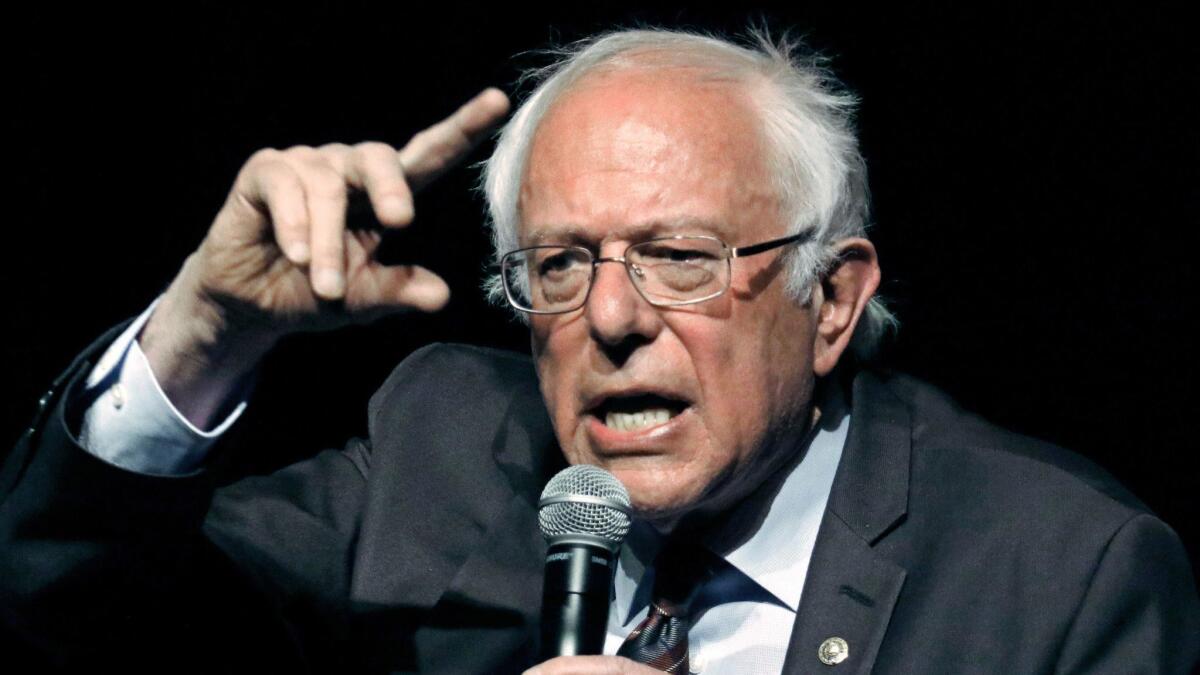Column: How a libertarian analyst inadvertently made a good case for Bernie Sanders’ Medicare for All

In this corner, Bernie Sanders, the former presidential candidate whose Medicare for All Act has become a rallying point for advocates of single-payer healthcare.
In that corner, Charles Blahous, an economics analyst who spent much of his tenure as a Social Security and Medicare trustee (2010-2015) arguing that the programs needed to be reformed, in part by cutting benefits. He also was a major figure in George W. Bush’s campaign to privatize Social Security.
Earlier this month, Blahous published a paper through the conservative Mercatus Center at George Mason University that aimed to bury the Sanders plan for good. He wrote that the cost of Medicare for All would be “substantially greater” than Sanders and his acolytes estimate, and would result in a massive increase in federal spending.
Yet some people are reading Blahous’ paper as actually making the case for Medicare for All. Among them is Ernie Tedeschi, a former economist at the Treasury Department now doing fiscal analysis for Evercore ISI, who points out that according to Blahous’ analysis, Medicare for All will reduce national health expenditures by $2 trillion over 10 years.
They’re right. Sanders himself tweeted victory on Monday, noting that “even a Koch brothers-funded attempt to trash Medicare for All can’t hide the truth.” (Koch family foundations have been big contributors to the Mercatus Center, where Charles Koch is a board member.)
But how could this be?
The answer lies in which numbers you think are important. Blahous focuses on the government share of total national health expenditures, which would more than double to about 95% from the current 45%. That would mean an increase in the federal budget of $32.6 trillion over the 10 years 2022-2031, which “by itself, is more than all federal individual and corporate income taxes projected to be collected during that period,” Blahous says. Pretty scary.
But as is often the case with analyses of single-payer costs, what Blahous leaves out is the other side of the ledger. This wouldn’t be an increase in healthcare spending, but a shift of funding from private pockets to the public purse. In fact, according to Blahous’ analysis, under Medicare for All overall U.S. spending on healthcare would be lower than currently projected in every year over the decade.
Taken all together, national health expenditures would total $57.6 trillion through 2031. They’re currently projected to be $59.7 trillion. In other words, Medicare for All would reduce total U.S. spending on healthcare by 3.44%. We asked Blahous to comment on the implications of his finding, but he didn’t reply.
In his paper, Blahous tries to conceal the implications of this figure by interpreting it as overall health expenditures remaining “virtually unchanged,” but this is merely an attempt at legerdemain. He skates over how much more Americans would get for their money under Medicare for All. As outlined by Sanders, health insurance would be provided for all Americans, including those currently uninsured. The government program would cover dental, vision and hearing care for everyone. Deductibles, coinsurance, copayments, and other cost-sharing bills would be eliminated.
Blahous argues that these features would increase healthcare demand and utilization, which he evidently views as an unalloyed sin. But that’s true only if one assumes that all or most of that increased demand would be for unneeded care. Where’s the evidence for that? On the contrary, it’s a safe bet that a good portion of care foregone by uninsured or underinsured individuals and families is, indeed, necessary, and quite a bit of it would contribute to lower spending down the line by treating medical problems before they turn acute or chronic.
The Blahous paper suggests that it’s a shame that all this expanded coverage and improved services would suck up the cost savings created by Medicare for All. According to Blahous’ reckoning, those include $5.3 trillion saved over 10 years by reducing physician and hospital reimbursements to Medicare levels, $846 billion on drug costs from negotiations with drug companies, and $1.57 trillion from reduced administrative costs.
Blahous is not wrong to consider some of those estimates to be “aggressive.” Cutting doctors’ pay to Medicare parity will be a heavy lift under any circumstances, and the drug savings certainly are conjectural. Blahous analyzes Sanders’ plan assuming no savings from provider pay cuts, showing even a larger federal burden, but that’s hardly a surprise, since the reduced spending on providers is the largest single factor in reducing costs.
Nothing says that the architects of a single-payer program can’t negotiate their way to a program that pays providers better than Medicare while, say, leaving some costs in individual hands or tweaking the program in some other way. The surprise is that Blahous’ analysis, which aimed to show that Medicare for All can’t possibly work, showed the way to make it work.
Keep up to date with Michael Hiltzik. Follow @hiltzikm on Twitter, see his Facebook page, or email [email protected].
Return to Michael Hiltzik’s blog.
More to Read
Sign up for Essential California
The most important California stories and recommendations in your inbox every morning.
You may occasionally receive promotional content from the Los Angeles Times.











